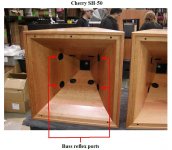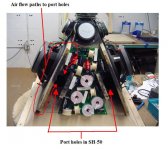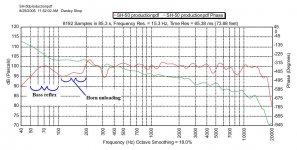I have the previous Exodus driver (ex-6.5) and I think it's an interesting candidate for the woofer in a 3-way Unity, but is entirely unsuited for use as a mid.
Why? Because it doesn't go high enough?
more specs here Introducing.... Anarchy. - Home Theater Systems - Electronics and Forum - HomeTheaterShack
Why? Because it doesn't go high enough?
more specs here Introducing.... Anarchy. - Home Theater Systems - Electronics and Forum - HomeTheaterShack
It is unusable as the mid because of the following: Fs is too low, Cms is too low, Vas is too high. This type of woofer does not have the correct T/S parameters to perform correctly in the Unity/Synergy horn.
What works best is paper cone mids with treated cloth surrounds. If it is an open frame mid, then Fs needs to be about 85Hz or higher. If it is a sealed back mid then Fs should be around 350Hz to 600Hz.
If it has a large rubber surround and a poly cone I don't even bother looking at it.
The Summa was designed to be the cleanest possible reproduction of a sound source, not the maximum output. Tom's designs all go after maximum output and compromise on performance to achieve that. Both design objectives are fine, but you have to remember that they are different and should each excel in that venue for which they are targeted. To your last point, its all one design and doesn't require "seperat(ing) out problems in the Unity/Synergy arrangement from more conventional problems". A problem is a problem.
I think you are ignoring what I see as the main design goal of the Synergy Horn. It is a point source with no lobes or cancelations in any direction. This is ok for pro sound but i think it may also be benefitial for home use. I guess you will argue this as this is something your design doesen't do.
There are much talk about the midranges in the Synergy horn, but I am more concerned about the bass. If you are after 300 - 400 hz performance in a single horn/waveguide you can achieve that with a large waveguide and a BMS compression driver. Just look at hulkss' thread. He got good polars down to about 400 hz. http://www.diyaudio.com/forums/multi-way/149085-testing-big-waveguide.html
The problem with a large waveguide like this is how to match it with the bass to get good polars. Here is the real benefit of the Synergy design. It's only the practical limitations of your room or your horn building skills that limits the upper size of a waveguide/horn like this. What I would like to see is some discussion about how to get good bass in a Synergy design. I see that Danley uses both tapped horn and sealed enclosure for the lowest pass band in similar designs (exampels: SH50 and SH25). This discussion might be appropriate for a new thread though.
It is a point source with no lobes or cancelations in any direction.
That has been claimed, but has not been established as far as I have seen.
It is unusable as the mid because of the following: Fs is too low, Cms is too low, Vas is too high. This type of woofer does not have the correct T/S parameters to perform correctly in the Unity/Synergy horn.
What works best is paper cone mids with treated cloth surrounds. If it is an open frame mid, then Fs needs to be about 85Hz or higher. If it is a sealed back mid then Fs should be around 350Hz to 600Hz.
If it has a large rubber surround and a poly cone I don't even bother looking at it.
What he said.
Also, this isn't specific to Unity horns; it applies to all horns in general.
Check out this thread, which is specific to this subject:
http://www.diyaudio.com/forums/multi-way/88237-suitable-midrange-cone-bandpass-mid-unity-horn.html
All of that said, I've found that it's possible to "cheat" these rules to an extent. The trick isn't getting the woofers to play low, it's getting them to play HIGH.
Here are some things you can do to "cheat" which are outside of the normal rules:
- Small woofers allow you to move the midrange closer to the compression driver, and this raises the upper limit. (The upper limit is set by the distance from compression driver to midrange, among other things.) If you want the mids to play to 1400hz, you'd want them about 2.5" away from the compression driver or less. (speed of sound / distance / 4)
- Light cones and accordian sounds work well because they raise the FS by lowering the QMS. Unfortunately, 75% of the woofers that fit that bill have motors that are nothing to write home about. It's almost 2010, I need shorting rings in my midranges.
- You can get away with a relatively heavy cone if the motor is unusually large. To my ears, the aluminum-coned computer speakers from TangBand and Peerless sound audibly superior to most paper coned prosound midranges.
- Theoretically, a phase plug is unnecessary on the midranges. But in my own experiments I've been able to extend the upper cutoff by almost an octave by using one. It's a lot of work, but it sure makes life easier on the compression driver.
I see that Danley uses both tapped horn and sealed enclosure for the lowest pass band in similar designs (exampels: SH50 and SH25).
Actually, when I examined the SH-50 and SH-46 it looked like they used bass reflex to get the last octave. The mouth is sized for Free Space and the bass reflex extends one octave below.
This is how I've been modeling my Synergy horns in Akabak. It works quite well to keep the size down while matching sensitivity. It also allows the flexibility of moving the bass reflex port around until it is in phase. My model has a mouth sized for Free Space at 167Hz, but the low end extends down to 85Hz.
Attachments
Actually, when I examined the SH-50 and SH-46 it looked like they used bass reflex to get the last octave. The mouth is sized for Free Space and the bass reflex extends one octave below.
This is how I've been modeling my Synergy horns in Akabak. It works quite well to keep the size down while matching sensitivity. It also allows the flexibility of moving the bass reflex port around until it is in phase. My model has a mouth sized for Free Space at 167Hz, but the low end extends down to 85Hz.
Ugh the plot thickens.
Why you gotta go and ruin my weekend man?
(Just kidding - this is very interesting info 🙂 )
JLH, it sounds like it may be time for a script update. Your stuff in the "Unity horn script for akabak " thread was very interesting. I for one would love to see your advances over the last year.
Actually, when I examined the SH-50 and SH-46 it looked like they used bass reflex to get the last octave.
Am I seeing things wrong? I think the SH-50 is a straight sealed 3-way, whereas the sh-69 is a bass reflex.
Patrick Bateman, what are your impressions summas vs unity, when listening from another room or walking around house. Which would you prefer as all day listen speaker? I'm asking because I almost never listen on axis and only care about non fatiguing sound, speech intelligibility and dynamics, and occasionaly clean and loud spl 🙂
Am I seeing things wrong? I think the SH-50 is a straight sealed 3-way, whereas the sh-69 is a bass reflex.
The SH-50, SH-46, SH-60 and SH-69 all use bass reflex. The SH-95 is sealed. That is why the SH-95 is rolled off around 200Hz.
Attachments
Last edited:
Ugh the plot thickens.
Why you gotta go and ruin my weekend man?
(Just kidding - this is very interesting info 🙂 )
Are you serious? I thought everyone here already knew about the bass reflex usage in the Synergy horns.

Attachments
Last edited:
JLH, it sounds like it may be time for a script update. Your stuff in the "Unity horn script for akabak " thread was very interesting. I for one would love to see your advances over the last year.
I'll make a new thread whan I'm ready to share my script. However, don't hold your breath. It will be a while before I post it.
P.S. The person that really deserves some credit is Mavo. He is the one that planted the seed. I just took what he posted and ran with it.
Last edited:
Without a doubt Mavo started the ball.I'll make a new thread whan I'm ready to share my script. However, don't hold your breath. It will be a while before I post it.
P.S. The person that really deserves some credit is Mavo. He is the one that planted the seed. I just took what he posted and ran with it.
No hurry, just knowing that you are still working from that base is enough to keep me playing with it. I just need to play with it some more. 😉
JHL, thanks for your explanations.
I thought Danley would use the tapped horn alignment because I read somewhere that the tapped horn idea came when he tried to figure out what to do with the backwave in the Synergy horn. When you have pointed out the bassreflex route it seems obvious.
I thought Danley would use the tapped horn alignment because I read somewhere that the tapped horn idea came when he tried to figure out what to do with the backwave in the Synergy horn. When you have pointed out the bassreflex route it seems obvious.
JLH'S picture of SH-50 and it's associated crossover could scare many a Nirvana and Fostex single-driver fan 😀
First really good larf today. Thanks Fred.JLH'S picture of SH-50 and it's associated crossover could scare many a Nirvana and Fostex single-driver fan 😀
The images it conjured......
U15 Project
Hello DWK - My U215's sound best via DEq2496 room correction - my somewhat cursory attempts at passive room correction did not come close to what I was able to achieve with a DEq. My next upgrade is to add a Gedlee style HOM foam filter.
Any ideas on what cabinet configuration will work best? I plan to keep my U215's as a free standing three box MTM hybrid. That way, I can add / remove the second LF driver as needed.
Getting time to post has been tricky, so lots to respond to.
The ideas for further mods include
- breaking out the xover connections to allow passive bi-amping (the U15s are bi-ampable in stock form, but this bypasses the woofer xover so you have to provide an active xover on the woofer branch).
- ditching the passive xover entirely and doing a FIR-based DSP xover (in theory I have all the necessary pieces for this, but it would be a major undertaking)
- new cabinets built directly into my corners, possibly including a back-set on the horn to allow a new large-radius mouth termination
- possibly some investigation on modifying the midrange ports in line with the ideas in the Synergy patent. I'd be really hesitant on this though, as the horn may not be replaceable.
Hello DWK - My U215's sound best via DEq2496 room correction - my somewhat cursory attempts at passive room correction did not come close to what I was able to achieve with a DEq. My next upgrade is to add a Gedlee style HOM foam filter.
Any ideas on what cabinet configuration will work best? I plan to keep my U215's as a free standing three box MTM hybrid. That way, I can add / remove the second LF driver as needed.
I'd like to see in a separate thread, "guesstimates" of how to successfully add the woofer making a 3-way Unity including estimate of its "front" exit holes position and practical diameter - just looking at the device. its drivers look closely packed. The vented woofer section is something like a parallel vent BP.
Both Dr. Geddes & Mr. Danley's approaches should be cost-effective and sonic improvements over prior art.
Both Dr. Geddes & Mr. Danley's approaches should be cost-effective and sonic improvements over prior art.
JLH'S picture of SH-50 and it's associated crossover could scare many a Nirvana and Fostex single-driver fan 😀
Ironically I've found that the Unity simplifies the crossover in a lot of ways, because you can get away with shallow crossover slopes. I've been able to get decent response with three or four crossover components. (This assumes that you're using EQ to flatten the response.)
There's a bit of a discussion of that here:
http://www.diyaudio.com/forums/multi-way/157806-power-response-acoustical-phase.html#post2034029
The commercially available models likely use a complex crossover to improve power handling, improve the phase response, and the commercial one doesn't need constant directivity EQ.
- Home
- Loudspeakers
- Multi-Way
- Gedlee Summa vs Lambda Unity Horn



